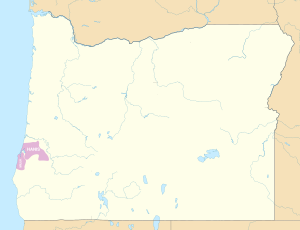Coosan languages facts for kids
Quick facts for kids Coosan |
|
|---|---|
| Kusan | |
| Ethnicity: | Coos people |
| Geographic distribution: |
Oregon |
| Linguistic classification: | Coast Oregon Penutian?
|
| Subdivisions: | |
 Pre-contact distribution of Coosan languages in Oregon
|
|
The Coosan (also called Coos or Kusan) language family included two languages. These languages were spoken by the Coos people along the southern coast of Oregon in the United States. Sadly, both of these languages are now extinct, which means no one speaks them anymore.
What Were the Coosan Languages?
The Coosan language family had two main languages:
These two languages were quite similar. Think of them like Dutch and German. They shared many words, but their grammar was different.
The name Coos might come from a Hanis word gus- meaning 'south'. Another idea is that it comes from a word ku·s from a different language, meaning 'bay'.
See also
 In Spanish: Lenguas kusanas para niños
In Spanish: Lenguas kusanas para niños

All content from Kiddle encyclopedia articles (including the article images and facts) can be freely used under Attribution-ShareAlike license, unless stated otherwise. Cite this article:
Coosan languages Facts for Kids. Kiddle Encyclopedia.
